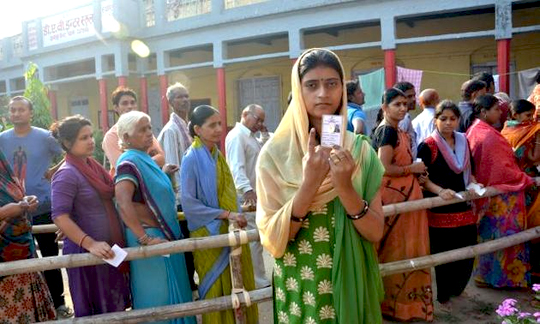Patna, Oct 28: About 27 per cent voter turnout was recorded till 12 noon in 50 Assembly constituencies spread over six districts of Bihar in the third phase of polling today.
Chief Minister Nitish Kumar, who cast his vote at polling booth number 204 at Bakhtiyarpur, faced protest from a section of people agitating over death of a girl allegdly due to lack of proper medical facility at Bakhtiyarpur bazar.
Other prominent personalities who voted today include Governor Ram Nath Kovind and his wife Savita Kovind, RJD chief Lalu Prasad, his wife Rabri Devi and son Tejaswi Yadav and former Deputy Chief Minister Sushil Kumar Modi.
Prasad and Rabri Devi cast their vote at polling station number 150 of Digha assembly constituency of Patna.
Union minister Ravishankar Prasad arrived at the polling booth riding an e-rickshaw with his mother. Minister of State Ramkripal Yadav rode a motorcycle to a booth at Jamal road in Patna to cast his vote.
Additional Chief Electoral Officer R Lakshamanan said around 26.94 per cent turnout has been reported from 50 Assembly constituencies in the third phase till 12 noon.
Polling is underway in six districts of Saran, Vaishali, Nalanda, Patna, Bhojpur and Buxar in this phase.
Meanwhile, in a freak incident a monkey injured four voters, including two women who were standing in a queue in front of the polling where Nitish Kumar had earlier cast his vote.
The incident took place at Project Girls School, Station House Officer of Bhakhtiyarpur police station Vinay Krishna said.
The booth falls under Bakhtiyarpur Assembly constituency.
A team of forest department arrived from Patna and were trying to catch the monkey.
As per hourly EC bulletin till 12 noon, Saran recorded 28.45 per cent turnout, Vaishali 30.53 per cent, Nalanda 27.39 per cent, Patna 23.03 per cent, Bhojpur 27.06 per cent and Buxar 30.05 per cent.
While Vaishali district recorded a maximum turnout of 30.53 per cent, Bhojpur recorded the lowest turnout of 27.06 per cent till 12 noon.
There were reports of EVM malfunctioning at a few places in the Assembly constituencies of Digha, Masaurhi, Mahnar, Buxar where polling began nearly an hour later.
Polling will end at 4 pm in 10 constituencies due to security reasons and at 5 pm in the rest 40 constituencies.
Voting on 81 seats has already completed in the first two phases on October 12 and October 16.
Two more rounds of polling would be held on November 1 and November 5 for the rest of the 112 seats in the 243-member Bihar Assembly. Results would be declared on November 8.







Comments
Add new comment